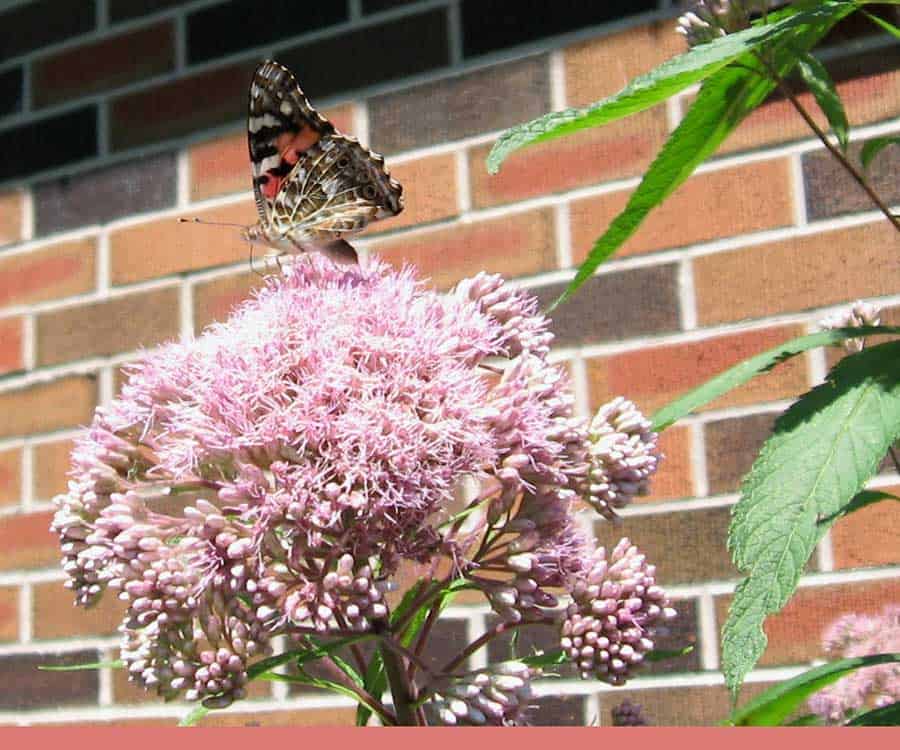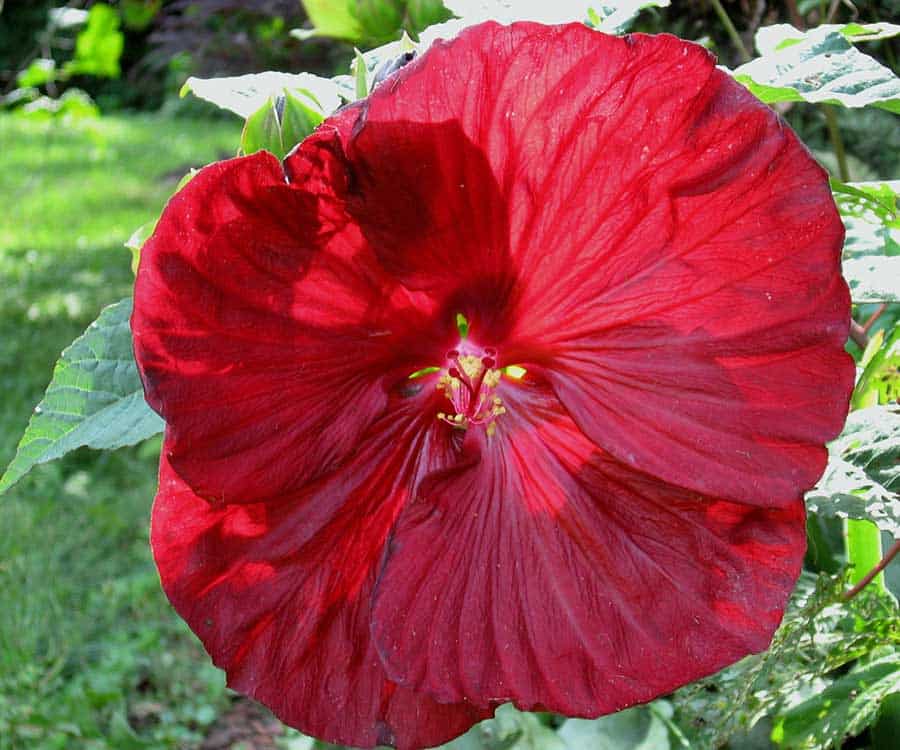
Those of us who live in cooler zones are already beginning to get subtle hints that autumn is not a million miles away: In my own garden this is signalled by the flowering of late summer perennials such as garden phlox (Phlox paniculata cvs.), the ripening of fruit and an increase in insect activity.
Here in south-central Ontario, I’m currently enjoying the generous blooms of native North American spotted Joe Pye weed and giant-flowered common rose mallow.
Spotted Joe Pye weed (Eutrochium maculatum and cvs.)
Native from Newfoundland to British Columbia and hardy to Zone 3, spotted Joe Pye weed is, without a doubt, one of the most striking and architectural of our native wildflowers. It sports whorls of pointed, purple-tinged green leaves on spotted stems that are topped with large panicles of pink flowers. Growing up to six feet (1.8 m) tall, in the wild Joe Pye weed prefers full sun in moist soils (ditches, damp meadows and wetlands) although it adapts well to average garden conditions.
My own clump of Joe Pye weed cleverly “planted itself” (likely with some avian assistance) at the base of one of my eavestrough downspouts where soil moisture is guaranteed — garden hipsters would probably call it a rain garden. And if your own backyard birds don’t cooperate with you to this extent, you can purchase some excellent purple-stemmed cultivars in the Atropurpureum Group (such as E. m. ‘Gateway’) at your local nursery. All Joe Pye weed varieties are important late-season nectar sources for long-tongued bees and a host of butterfly species.
Formerly members of the genus Eupatorium, most North American Joe Pye weed species (that is, types with whorled leaves) have recently been moved into Eutrochium in order to separate them from the European eupatoriums (or bonesets) that bear opposite leaves. The common name for Eutrochium maculatum is derived from the legend of Joe Pye (or “Jopi”), a First Nations healer from the Carolinas who used the plant to treat pioneer settlers suffering from typhoid fever.
Renowned British horticulturist Graham Stuart Thomas (1909-2003) recommended pairing Joe Pye weed with pink hybrid musk roses (such as ‘Ballerina’, ‘Belinda’ and ‘Vanity’) and Hydrangea paniculata cultivars.

Common rose mallow (Hibiscus moscheutos cvs.)
I always look forward to the late summer blooms of my ‘Robert Fleming’ common rose mallow with its over-the-top 10-inch (25-cm)-wide burgundy-red flowers. Visitors often assume it’s a tropical annual, but in fact it’s hardy to Zone 5 and native to southern Ontario. Also known as swamp rose mallow, Hibiscus moscheutos (pronounced moss-KEW-tos, and meaning “musk-scented”), enjoys the same sunny, consistently moist soil conditions as Joe Pye weed does, and they make great plant partners.
Common rose mallow first enjoyed widespread attention from gardeners thanks to the efforts of three brothers — James, Robert and David Fleming — who spent the last half of the 20th century perfecting what they called the “Fleming Hardy Hibiscus” (now Fleming Hybrids) at their nursery in Lincoln, Nebraska. After the Fleming brothers retired, Illinois-based plant breeder Ellen Leue began to introduce cultivars from her H. m. Luna Series in the early 2000s, extending the colour palette of common rose mallow to include flowers with swirling colour patterns and picotée edges.
Almost all of the cultivars in commerce today have been crossed at some point in their family trees with other Hibiscus species to improve branching and control size; most new varieties grow a compact three feet (90 cm) tall by two feet (60 cm) wide. And although my specimens are all solid red, it’s more usual for blooms to have a contrasting eye (for example, white petals with a dark pink centre).
I often wonder why common rose mallow isn’t more “common” in Canadian gardens. One reason may be that the plants are maddeningly slow to emerge in spring, and sometimes gardeners mistakenly toss them out believing them to be dead. I always leave the leafless stems of common rose mallow in place over winter (to mark the spot) and don’t cut them back until new growth begins to show itself in late spring or early summer. But without a doubt, their ginormous blooms are certainly worth the wait!









Serendipitous! I just published my garden column in today’s STRATFORD BEACON HERALD on, yes, Joe Pye Weed. Rose Mallow sounds pretty cool and I’ll watch for it.
Doug Reberg Stratford, ON.
Can you grow the Hibiscus Moscheutos from seed, and if so, where is seed available in Canada? thank you.
I grow the rose mallow too. It’s new to me, just had it two years. I mark it so I know where it is, and it breaks ground about June 1. That is in full sun too. I love it, mine is Dark Pink with a red eye and so big and has lots of blooms.
I grow both Joe Pye Weed and Common Rose Mallow. I purchased one plant from Wild Things Plant Farm and over the years it has slowly spread. It is not planted in a wet area and during a dry spell, it will slump over. I will give it extra water occasionally but for the most part let it do its own thing. I like the flowers as they are quite impressive. I have five different colours of the Common Rose Mallow and they are starting to show signs of budding. Four were just planted last fall so the plants are still small. I did not realize they required extra water so will start doing that during dry spells.